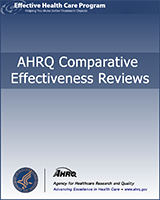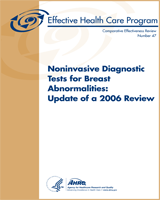NCBI Bookshelf. A service of the National Library of Medicine, National Institutes of Health.
Bruening W, Launders J, Pinkney N, et al. Effectiveness of Noninvasive Diagnostic Tests for Breast Abnormalities [Internet]. Rockville (MD): Agency for Healthcare Research and Quality (US); 2006 Feb. (Comparative Effectiveness Reviews, No. 2.)
This publication is provided for historical reference only and the information may be out of date.

Effectiveness of Noninvasive Diagnostic Tests for Breast Abnormalities [Internet].
Show detailsCurrently, biopsy is the only accepted method to accurately differentiate benign from malignant breast lesions. Although a biopsy is a safe procedure, patients may experience high anxiety, temporary loss of productivity, and various degrees of surgical trauma and cosmetic alteration; and each procedure places cost and personnel demands on the health care system. Reducing the number of biopsies through non-invasive technologies is desirable. However, how accurate does a test have to be before it becomes an acceptable and appropriate alternative to biopsy? This decision ultimately depends upon what society considers an acceptable rate of missed cases of cancer. An analysis by the Ontario Ministry of Health concluded that a negative predictive value of 98% or greater would be an acceptable level for a diagnostic test to reliably preclude breast biopsy.80 With a negative predictive value of 98%, 20 cases of breast cancer would be missed in exchange for avoiding 980 unnecessary biopsies.
Our analysis found that in a patient population with a prevalence of breast cancer of 20%, MRI would miss 38 cases of breast cancer in exchange for avoiding 962 unnecessary biopsies; ultrasound would miss 50 cases of breast cancer in exchange for avoiding 950 unnecessary biopsies; PET scanning would miss 76 cases of breast cancer in exchange for avoiding 924 unnecessary biopsies; and scintimammography would miss 93 cases of breast cancer in exchange for avoiding 907 unnecessary biopsies. These numbers are calculated from the summary negative likelihood ratios, and assume 1,000 women with suspicious lesions diagnosed as cancer-free by each particular test will choose to forego biopsy. If a similar analysis is performed using the negative predictive value derived from the SROC curves, similar results are obtained. For example, for scintimammography, at the mean threshold for a population with a prevalence of 20%, the negative predictive value derived from the SROC curve is 91.6%, and the negative predictive value derived from the summary likelihood ratio is 90.7% (95% confidence interval 89.1 to 92.2). The minor difference in results between methods of analysis is within the expected error range.
The numbers above are based upon an average risk of breast cancer for a women referred for breast biopsy. However, an individual woman's risk of breast cancer in the face of a suspicious finding on mammogram or clinical examination may vary widely, depending upon the findings and her own situation; the extent of cancer risk should be discussed by the woman and her health care provider. In general, the higher a woman's risk of cancer before undergoing a non-invasive imaging test, the higher the risk that she has cancer even if the test is negative.
We used a prevalence of breast cancer of 20% in the above calculations because Banks et al. reported a prevalence of breast cancer of 11.6% to 24.4%, depending on age, for more than 100,000 unselected patients with positive mammograms.46 From the descriptions of the patients enrolled in the majority of the studies, one might expect these patients to be similar to those described by Banks et al. However, a potential limitation of the available studies is the high prevalence of breast cancer in the patients enrolled in them. Prevalences of 50% or higher were reported for most patient groups studied (except for studies of ultrasound, with a more reasonable prevalence of 24%). These high prevalences suggest that the studied women were not representative of the general population of women with suspicious findings after breast cancer screening exams. Therefore the negative predictive values calculated from these studies may not be directly applicable to the clinic (because negative predictive values are dependent on disease prevalence). Sensitivity, specificity, and negative likelihood ratios are independent of prevalence; however, they are dependent on the spectrum of disease present in the patient population. If the patients enrolled in the included studies had disease that was more advanced than that in the typical clinical population (a possibility suggested by the high prevalence rates), the resulting estimates of test performance may not be directly applicable to the clinical situation. As such, our strength of evidence ratings apply only to the internal validity of these studies, as applied to the populations that were enrolled. Because the evidence bases for PET, scintimammography, and MRI appear to be affected by spectrum bias, care should be taken when attempting to apply these results to any other patient populations.
A clinical use of non-invasive imaging technology that we were unable to address in this report, due to an absence of evidence, is examination of women with probably benign lesions. Women who have probably benign findings on mammography screening, or unusable findings (BIRADS 0 or 3) are commonly referred for more frequent mammography screening tests. Mammography does expose patients to x-rays, and is often reported to be uncomfortable; and of course, women must suffer from considerable mental distress from the months of not knowing for sure if they are healthy. It is possible that non-invasive imaging could be used to accurately detect suspicious cases in this population. These women would be referred for further evaluation, and the other patients could return to routine screening. Because these women have a completely different spectrum of disease than the women enrolled in the published studies, we cannot extrapolate our findings to this population group. Further research is necessary on this possible use of non-invasive imaging technology.
Further research on these diagnostic imaging procedures is desirable. The most informative study design would randomize women with suspicious findings to either be directly followed up by biopsy, or by a non-invasive imaging method first, and only women with positive findings on imaging would be evaluated by biopsy. Ideally, all women in the study would be followed for many years, and patient-oriented outcomes such as mortality and quality of life recorded. Such a study would directly address the question of whether women benefit from being evaluated by non-invasive imaging methods. However, a study of this type would be expensive, time-consuming, and may present ethical issues about delayed cancer diagnoses. A more feasible approach to further research would be to conduct diagnostic cohort studies on patient populations more representative of the general population of women with suspicious findings after breast cancer screening. A cost-benefit analysis of data from such studies would indirectly address the question of whether women benefit from being evaluated by non-invasive imaging methods.
In conclusion, an ideal test to evaluate breast abnormalities found by mammography or breast examination would distinguish women who needed to have a biopsy from those who could safely avoid one. A woman who has a negative test result should be very confident that she does not have breast cancer before deciding to forgo a biopsy. The risk of a test missing a cancer is dependent on a woman's risk of cancer prior to undergoing a test as well as the accuracy of the test. While an “acceptable” level of risk of cancer given a negative test result is dependent on a woman's personal preferences; at least one organization, the Ontario Ministry of Health, has suggested that a 98% negative predictive value threshold would be societally acceptable to reliably preclude breast biopsy. Evidence suggests that for women at average risk of breast cancer receiving a biopsy in the US, all four of the diagnostic tests evaluated in this report fall short of this 98% threshold. While MRI was more sensitive than the other technologies in typical usage, even this technology would result in a 96% negative predictive value for a woman at average risk; women at higher risk would have an even lower negative predictive value.
- Overall Summary - Effectiveness of Noninvasive Diagnostic Tests for Breast Abnor...Overall Summary - Effectiveness of Noninvasive Diagnostic Tests for Breast Abnormalities
- Mumps infectious diseaseMumps infectious diseaseMedGen
Your browsing activity is empty.
Activity recording is turned off.
See more...
